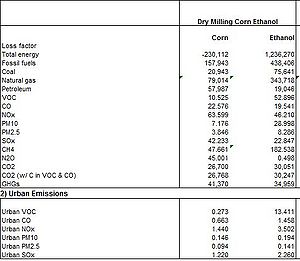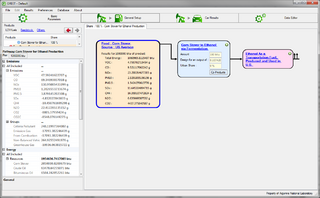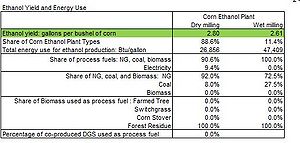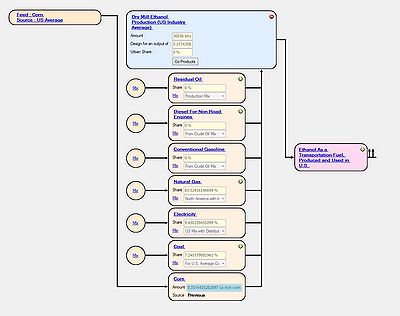Ethanol: Difference between revisions
Aelgowainy (talk | contribs) |
Aelgowainy (talk | contribs) |
||
| Line 19: | Line 19: | ||
==Main Input== | ==Main Input== | ||
The main input refers | The "main" input refers to the initial amount of primary resource (main feedstock) put into a fuel's production pathway. For example the main input of corn-ethanol pathways would be corn. In the case of Compressed Natural Gas the main input would be natural gas in the well. Both GREET Excel and GREET.net incorporate the "main" input into their life cycle calculations. However, the way it is accounted for in each model is different. In the .net model, the energy in the main input is always added to the results of the first process in the pathway (the recovery of the main feed from its primary source in nature). However, this is not the case for GREET Excel. | ||
In the ETOH sheet of | In the ETOH sheet of GREET Excel, is not accounted for in the final results. This can easily be noted by comparing results between the two models. To compare corn ethanol data in GREET Excel with that in GREET.net, one must first add the results of the Fuel and the Feed in the summary table because as described above GREET.net does not make that distinction. Once added together, one will notice that the emissions (VOC, CO, NOx, PM10, SOx, etc.) are matching between the two models. However, the energy is off by a factor of one million btu. This is because in Greet.net we include the initial one million but from the main input, but in Greet Excel they do not. To compare the results simply add a million to excel or subtract a million for the .net results. | ||
In the case of | In the case of sugarcane ethanol and corn acetone the main input is not one million btu, so one must subtract the portion of the energy represented by the main input. This will be specified as sugar cane or corn respectively in the Greet.net results. It must be stressed that in regards to the main input what is done in Greet Excel or what is done in Greet .net are both right. It is simply two different ways to interpret the same data. | ||
==Yields== | ==Yields== | ||
Revision as of 20:27, March 21, 2012
Introduction/Preface
The implementation of the .net version of GREET required us to track the data and calculations in the ETOH sheet of the Excel version of GREET. The ETOH data sheet contains some calculations that are specific to the corn ethanol production and not common with other fuel production pathways in GREET. This includes fuel yield, land use changes, and co-product types and handling. The purpose of this document is to summarize these differences, and explain in details the execution of this portion in the .net model.
Feed & Fuel
In GREET excel, The energy and emissions results are split between "feed" & "fuel" in the summary tables for the fuel pathways at the bottom of each fuel recpective sheet. The energy and emissions allocated to the "fuel" in the summary tables refer to the energy and emissions associated with process fuels use in the production process (excluding the amount of the feed with energy equivalent to the energy in the produced fuel). The energy and emissions allocated to the "feed", or feedstock, refer to the energy and emissions associated with extracting, processing and transporting an amount of the feed (with energy content equivalent to the energy in the produced fuel) to the fuel production plant. In the case of Conventional Gasoline, crude is the feed. Examples of feed and fuel in GREET excel are shown in the table to the right.
In our implementation of GREET.net we do not split fuel from feed. We sum all our data on a life cycle basis. The final results we generate encompass both feed and fuel. However, a user of the GREET.net can easily obtain the energy and emission data pertaining to a certain process in the fuel life cycle. The upstream energy use and emissions are also provided in conjunction with each process results.
Below is a screen shot of Corn Stover to Ethanol pathway in GREET.net. The results shown to the left are for the final process in the pathway, which is the transportation process. Since this is the final process the results shown are for the entire life cycle for the ethanol fuel product. If a user is interested in the data up to the process immediately before the transportation process, the user can simply select that process (by pressing its icon), and GREET will show the results for the selected process, including the upstream processes all the way to the primary source of energy (main feedstock).
In addition it should be noted that at the beginning of the pathway their is a "Feed", representing Corn Stover in the above example. By hovering your mouse over the "Feed" it expands revealing the energy and emissions data associated with extracting, processing and transporting the amount of feed required for the production process (see screen shot below). By click the hyperlink in the "Feed: Corn Stover" frame, the pathways and processes associated with extracting, processing and transporting corn stover to the ethanol plant will be shown. Once again a user can click on any of these processes to view the energy use and emissions associated with these processes.
Main Input
The "main" input refers to the initial amount of primary resource (main feedstock) put into a fuel's production pathway. For example the main input of corn-ethanol pathways would be corn. In the case of Compressed Natural Gas the main input would be natural gas in the well. Both GREET Excel and GREET.net incorporate the "main" input into their life cycle calculations. However, the way it is accounted for in each model is different. In the .net model, the energy in the main input is always added to the results of the first process in the pathway (the recovery of the main feed from its primary source in nature). However, this is not the case for GREET Excel.
In the ETOH sheet of GREET Excel, is not accounted for in the final results. This can easily be noted by comparing results between the two models. To compare corn ethanol data in GREET Excel with that in GREET.net, one must first add the results of the Fuel and the Feed in the summary table because as described above GREET.net does not make that distinction. Once added together, one will notice that the emissions (VOC, CO, NOx, PM10, SOx, etc.) are matching between the two models. However, the energy is off by a factor of one million btu. This is because in Greet.net we include the initial one million but from the main input, but in Greet Excel they do not. To compare the results simply add a million to excel or subtract a million for the .net results.
In the case of sugarcane ethanol and corn acetone the main input is not one million btu, so one must subtract the portion of the energy represented by the main input. This will be specified as sugar cane or corn respectively in the Greet.net results. It must be stressed that in regards to the main input what is done in Greet Excel or what is done in Greet .net are both right. It is simply two different ways to interpret the same data.
Yields
The ETOH sheet utilizes yields to indicate the amount of product that can be produced from a certain amount of feed. For example they will indicate how much corn it takes to create a single gallon of Ethanol, or how much switch grass is needed to create a single gallon of ethanol fuel. Throughout the ETOH sheet corn, herbaceous and etc. data are calculated at a per bushel basis. They show how much energy is consumed and how many emissions are produced per bushel of feed harvested. However, they calculate the ethanol production in a per gallon basis. In other words how much energy and how many emissions per gallon of Ethanol produced. The yields fills the gap between these two ways of calculated results, so that a totaled result can be calculated in a per one million btu basis. Screen shots of the yields shown in Greet Excel are shown. They are primarily found in two tables. In the screenshot they are highlighted in green so they can be easily identified.
In Greet.net these yield are used in a very similar fashion. The "Feed" portion of our data would be calculated in a per bushel basis, and then it is imputed into a fuel production pathway designed for a per gallon basis. This is shown in the screenshot below. The yield value is in a text box highlighted in blue:
Co-Products
In both Greet.net and Greet Excel Co-Products are a form of credit. A Co-product is something that is produced along side the main product. The energy content of this co-product and emissions saved by otherwise producing it from scratch are credited back to the process. To calculate this credit we specify different resources that are displaced. Their are many co-products in the ETOH spread sheet. The calculation for a Co-production are very straight forward. Below they are shown for energy, but the calculation is exactly the same for emissions:
Credited Energy and Emissions associated to the coproduct
Overhead energy and emissions associated to the production of the displaced resource
The is provided from that resources specific mix and the displacement ratios are calculated in the ETOH sheet. For more information on how Co-Products are implemented in Greet.net refer to the Co-Products section of the wiki.
It should be noted that the displacement calculations done in GREET.net is accounting the energy of the displaced material. The Excel spreadsheet calculations can be adjusted as shown below:
Energy content of the displaced resource
This is mostly due to the fact that we decided to not make a distinction between the main inputs or the process fuels of a process. Therefore whatever is necessary as an input to produce some material is taken into account. However in Excel the main input is almost never accounted.
If the displaced material has a heating value of zero will be null and the results of Excel and .net will match without any adjustment.












